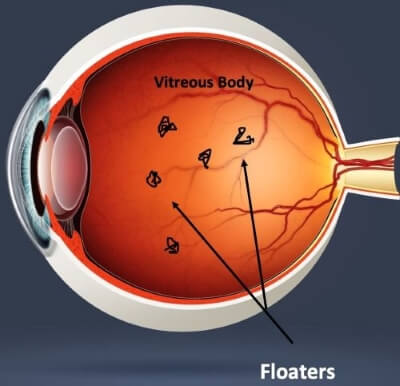
The "flying flies" or "dots" that you may sometimes see moving in your field of vision are called floaters. They are frequently visible when looking at a plain background, such as a blue sky. Floaters are actually tiny clumps of gel or cellular debris inside the vitreous, the jelly-like fluid that fills the inside cavity of the eye.
Although the floaters appear to be in front of the eye, they are actually floating in the vitreous fluid inside the eye and cast their shadows on the retina, the light sensing inner layer of the eye. Moving our eyes up and down creates current within the vitreous capable of moving the floaters away from your direct line of vision.
In middle age, the vitreous gel degenerates as a result of shrinkage or condensation, often forming clumps or strands within the eye. Vitreous shrinkage or condensation is called posterior vitreous detachment and is a common cause of floaters. It also occurs frequently in shortsighted people or in those who have undergone cataract operations.
The appearance of floaters, whether in the form of little dots, circles, lines or clouds may be alarming, especially if they develop suddenly. However, they are usually nothing to be concerned about, and simply result from the normal ageing process

Occasionally, the retina is torn when degenerated vitreous gel pulls away. This causes a small amount of bleeding in the eye which may appear as a group of new floaters
A torn retina can be serious if it develops into a retinal detachment. Any sudden onset of many new floaters or flashes of light should be promptly evaluated by your eye doctor.
Floaters may interfere with clear vision and when reading, it is often annoying. There is no treatment or cure for floaters and they usually diminish by themselves over time. You can take simple measures to temporarily move them from your sight.
If a floater appears directly in your line of vision, try moving your eye around. The inside fluid may swirl and allows the floaters to move out of the way. Looking up and down will also cause different currents within the eye and may also be effective in getting the floaters out of the way.
When the vitreous gel which fills the inside of the eye rubs or pulls on the retina, it sometimes produces the illusion of flashing lights or lightning streaks. The flashes of light may appear on and off for several weeks or months. This usually occurs as we grow older and is usually not a cause for worry.
On rare occasion, however, light flashes accompany a large number of new floaters and even a partial loss or shadowing of side vision. When this happens, prompt examination by an eye doctor is important to determine if a torn retina or retinal detachment has occurred.
As with floaters, if you experience the abrupt onset of many light flashes you should be examined by eye doctors . The examination will involve a careful observation of the retina and vitreous gel after your pupils have been dilated with eye drops.
* This is a general guide. If in doubt, please consult your doctor.
Visit us at Insight Eye Clinic and experience unrivalled professional service from the moment you step in. We offer best eye flashes and floaters treatment in Mumbai and assure our clients the highest quality eye care.
